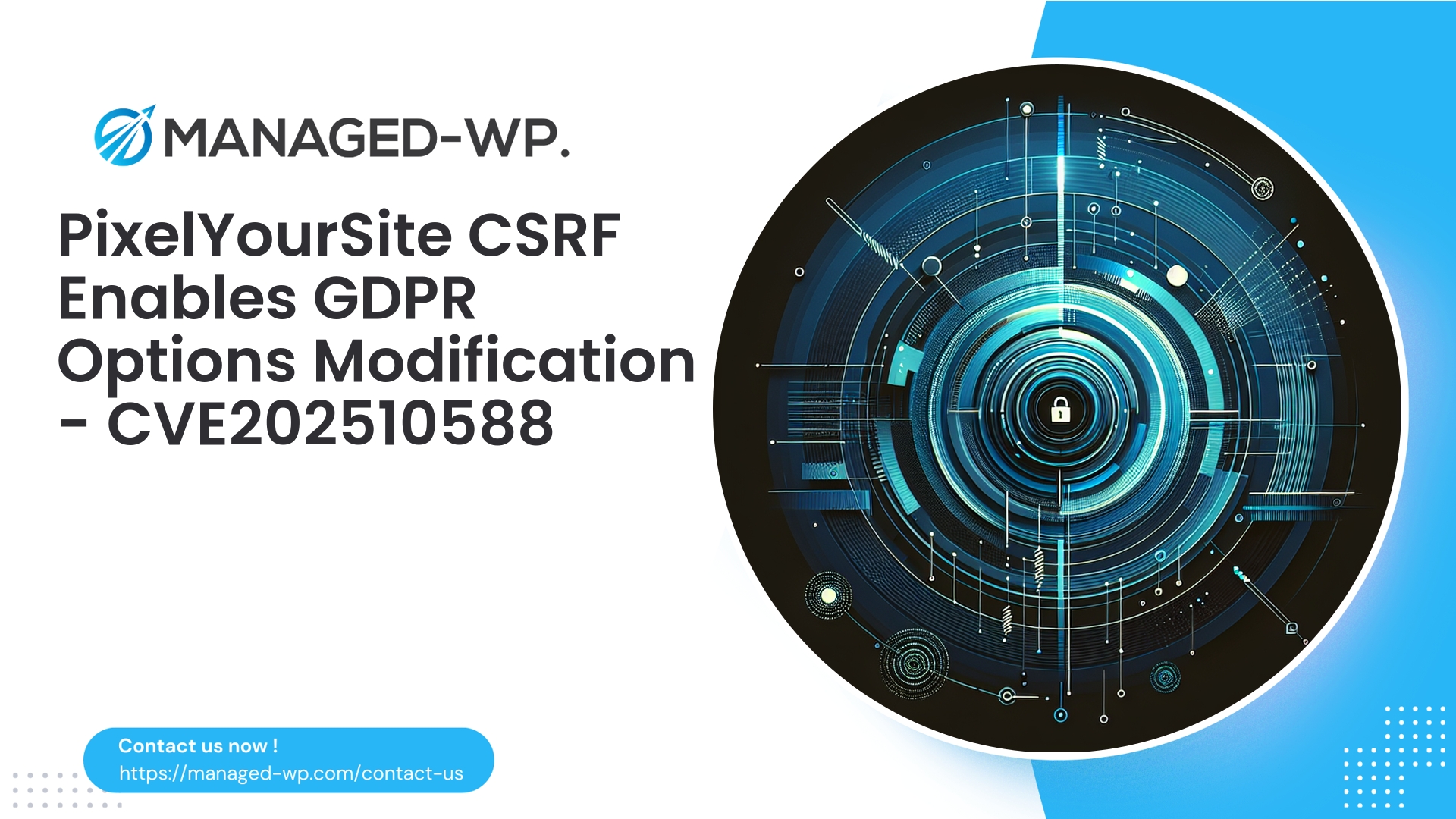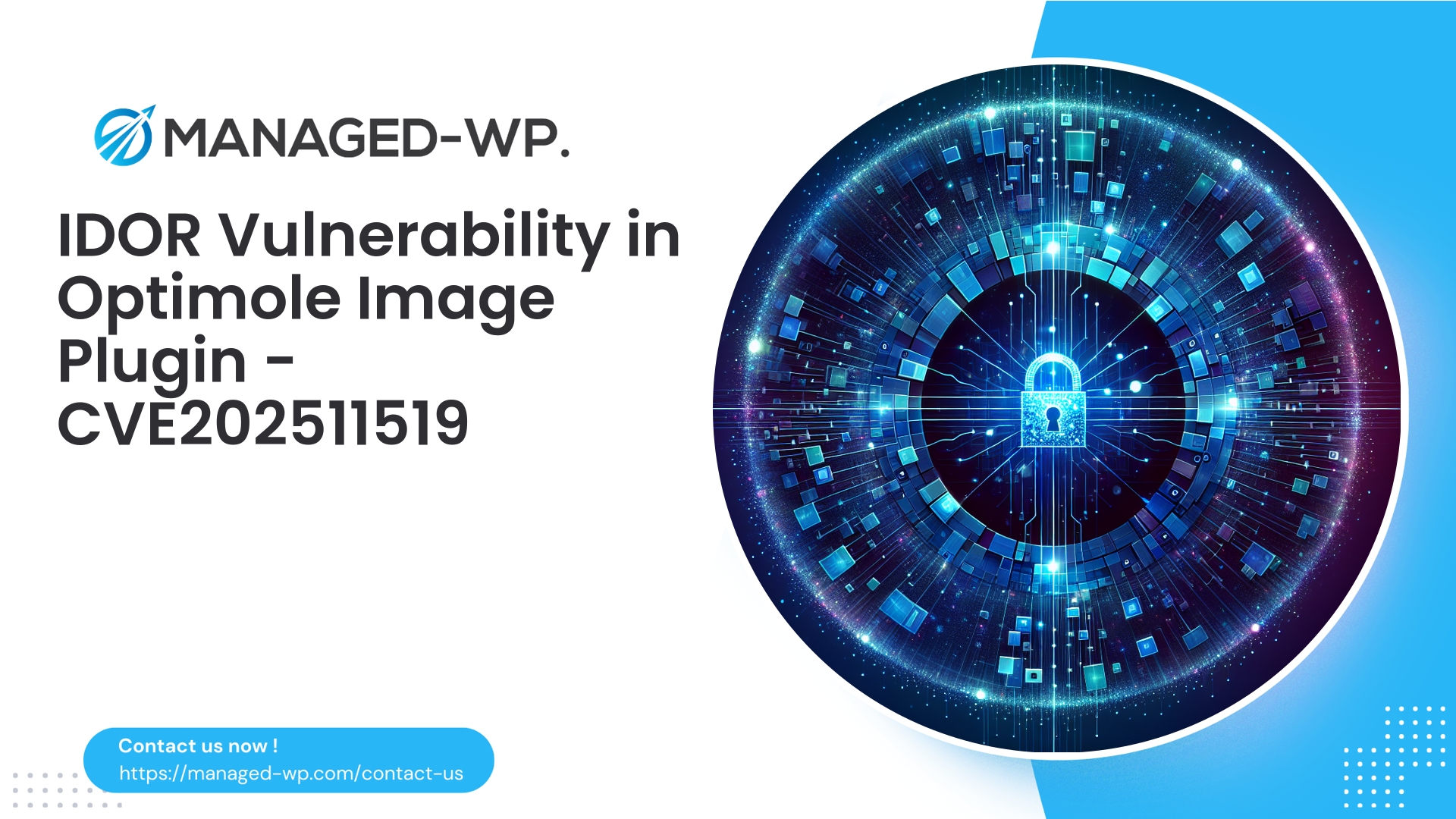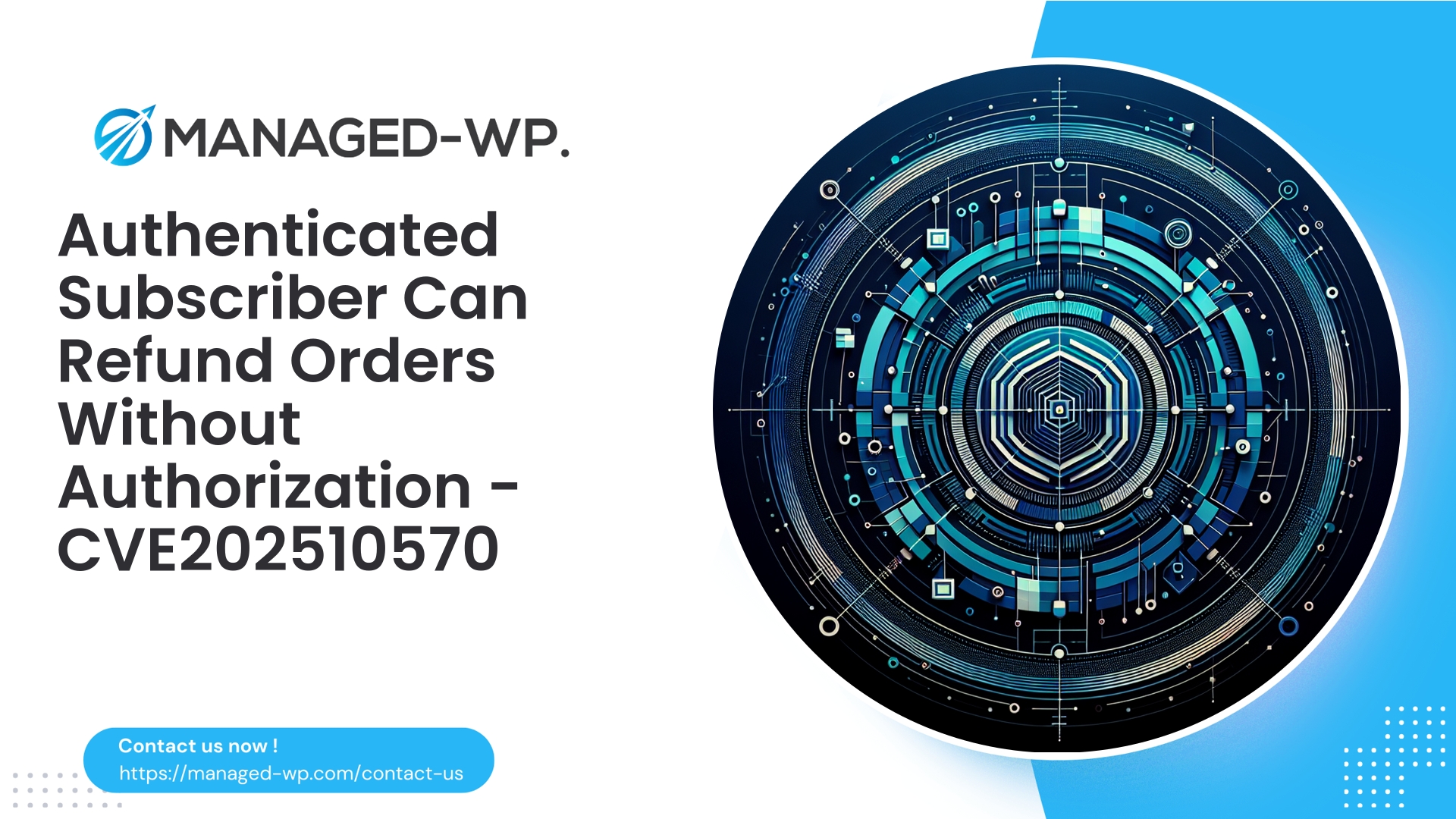| 插件名称 | PixelYourSite |
|---|---|
| 漏洞类型 | CSRF |
| CVE编号 | CVE-2025-10588 |
| 紧急 | 低的 |
| CVE 发布日期 | 2025-10-21 |
| 源网址 | CVE-2025-10588 |
PixelYourSite <= 11.1.2 — 影响 GDPR 设置的 CSRF 漏洞 (CVE-2025-10588):WordPress 网站所有者应立即采取的措施
WordPress 插件 PixelYourSite 存在跨站请求伪造 (CSRF) 漏洞,已发布严重安全公告,该漏洞影响所有版本,包括 11.1.2 及更早版本。攻击者可利用此漏洞在未经管理员明确授权的情况下修改关键的 GDPR 相关配置。尽管该漏洞的 CVSS 评分较低(4.3),但其对隐私合规性和网站信任度的影响不容忽视,所有使用此插件的 WordPress 管理员都应立即予以重视。
作为值得信赖的 WordPress 安全托管解决方案提供商 Managed-WP 的安全专家,我们在此提供一份简洁权威的漏洞分析报告。我们的目标是为网站所有者提供清晰的指导,帮助他们立即有效地保护其网络环境。
执行摘要——关键步骤
- 立即将 PixelYourSite 升级到 11.1.3 或更高版本,以获取官方安全补丁。
- 如果无法立即更新,则应采取缓解措施,例如加强管理员访问控制、启用多因素身份验证以及部署能够阻止 CSRF 尝试的高级 Web 应用程序防火墙 (WAF)。
- 更新后,对 GDPR 和同意设置进行彻底审核,以验证系统完整性。
- 启用全面的日志记录机制,并扫描异常配置更改或未经授权的管理活动。
- 考虑通过 WAF 规则实施虚拟修补,以降低在所有站点应用补丁时的风险。
以下各节将深入解释该问题、利用场景,并为 Managed-WP 客户和 WordPress 网站所有者提供优先补救路线图。
了解漏洞
CSRF攻击会诱使已认证用户的浏览器在Web应用程序上执行非预期操作。在这种情况下,恶意攻击者可以利用活跃的管理员会话,在未经用户明确同意或知情的情况下,提交伪造的请求来更改PixelYourSite的GDPR相关选项。
关键细节包括:
- 插件: PixelYourSite — 智能像素和标签管理
- 受影响的版本: ≤ 11.1.2
- 已修复: 11.1.3
- 漏洞类型: CSRF
- CVE标识符: CVE-2025-10588
- 攻击向量: 无需文件上传或远程代码执行;利用已认证的管理员会话
通过操纵 GDPR 同意功能,攻击者可以禁用或修改跟踪限制,从而危及用户隐私合规性并破坏访客信任。
为什么“低”CVSS评分不应让你掉以轻心
虽然技术上的严重程度较低,但其对商业和法律的影响可能相当巨大:
- 由于未经授权更改同意流程,违反了 GDPR 和隐私指令。
- 通过篡改跟踪控制措施,损害了分析数据的完整性。
- 可能成为更高级攻击的跳板(例如,通过操纵跟踪脚本实现会话劫持)。
- 通过针对已登录管理员的自动化攻击活动,可以实现大规模滥用。
因此,Managed-WP建议无论CVSS评级如何,都应迅速采取补救措施。
攻击场景
- 社会工程
- 网络钓鱼邮件或聊天信息诱骗管理员在登录 WordPress 时点击精心制作的链接。
- 无意中点击提交伪造请求,更改 GDPR 插件设置。
- 恶意网页
- 攻击者托管外部页面,每当管理员访问时,这些页面都会自动向易受攻击的网站提交隐藏请求。
- 连锁漏洞
- 利用其他插件或主题中存储的跨站脚本 (XSS) 漏洞,在管理员会话中触发 CSRF 有效载荷。
在所有情况下,攻击者都依赖于缺乏强大的 CSRF 保护的已认证管理员会话的存在。
PixelYourSite 用户行动计划
立即执行以下措施,优先执行前三步:
- 升级到 11.1.3 或更高版本:
- 通过 WordPress 控制面板:插件 → 已安装插件 → PixelYourSite → 更新
- WP-CLI 命令:
wp 插件更新 pixelyoursite - 如果管理多个站点,请制定应急部署计划
- 如果无法立即进行修补,则可采取以下临时缓解措施:
- 在可行的情况下,通过 IP 白名单限制管理员访问权限。
- 强制使用强密码并启用多因素身份验证。
- 避免从 WordPress 管理工作站浏览不受信任的网站。
- 部署 WAF 规则,专门阻止针对 PixelYourSite 的已知漏洞利用模式。
- 更新后验证:
- 审核 GDPR/同意设置,检查是否存在未经授权的更改。
- 查看最近的管理员活动和配置更改。
- 检测可疑活动:
- 运行全面的网站和数据库扫描,以识别意外的修改。
- 分析服务器日志,查找向 PixelYourSite 管理端点发出的异常 POST 请求。
- API密钥轮换和集成审查:
- 检查第三方集成,如果发现可疑更改,请轮换凭据。
- 备份验证:
- 在进行重大更改或修复之前,请确保有最新的备份可用。
- 实施监控和安全最佳实践:
- 启用管理员操作的审计日志记录。
- 严格执行角色管理和权限分离。
入侵指标(IoC)
请检查以下迹象,以确认您的网站是否已成为攻击目标或遭到入侵:
- PixelYourSite 中 GDPR 或同意设置发生了意外更改。
- 来自外部或可疑来源的异常 POST 请求发送到插件管理 URL。
- 在没有相应用户输入的情况下发生的管理操作(审计日志对此有所帮助)。
- 在您的网站上注入或修改内联脚本,以模仿跟踪开关。
- WAF 反复发出关于可疑 PixelYourSite 请求模式的警报。
检测到时:
- 立即将设置恢复到预期状态。
- 对网站进行全面扫描,排除更大范围的入侵可能性。
- 要求所有管理员立即重置密码并启用多因素身份验证 (MFA)。
- 如果需要披露敏感数据或通知监管机构,请咨询法律顾问。
检测和记录建议
- 检查 Web 服务器日志中是否存在针对目标服务器的 POST 请求
admin-post.php或者与 PixelYourSite 关联的插件特定管理端点。 - 查询 WordPress 数据库以获取 PixelYourSite 选项的最新更改,并与备份进行交叉引用。
- 使用 WP-CLI 或系统工具验证插件文件的修改时间戳。
- 利用活动/审计日志插件跟踪管理员设置更改。
grep "POST .*admin-post.php" /var/log/nginx/access.log | grep "POST .*admin-post.php" /var/log/nginx/access.log | grep“像素你的网站”根据您的日志系统和插件端点调整命令。
面向开发人员和系统管理员的指南
为防止 CSRF 漏洞,请遵循以下安全编码和操作最佳实践:
- 使用以下方式实现 nonce
wp_nonce_field()在表单中并进行验证检查管理员引用者()或者wp_verify_nonce()处理请求时。 - 强制执行能力检查,例如
current_user_can('manage_options')适用于所有敏感操作。 - 禁止通过 GET 请求更改状态;严格允许通过 POST 请求并进行 nonce 验证。
- 使用 WordPress 的清理功能,对所有传入的数据进行彻底的清理和验证。
- 使用独特、不可预测的操作名称,并保护管理端点。
- 在适当情况下,通过引用标头检查来加强保护,作为 nonce 验证的补充。
- 在访问控制中始终贯彻最小权限原则。
维护 PixelYourSite 或类似插件的开发者应该将 CSRF 保护测试集成到他们的自动化流程中。
托管式 Web 应用程序防火墙 (WAF) 如何提供帮助
Managed-WP 的先进 WAF 解决方案通过以下方式提供即时保护:
- 阻止 PixelYourSite 上类似已知 CSRF 攻击的请求。
- 检测缺少有效 nonce 或源自可疑引用源的异常 POST 流量。
- 在数千个站点上快速部署虚拟补丁,为补丁的采用争取关键时间。
- 完善身份验证控制措施,例如 IP 限制和多因素身份验证。
重要的: WAF 是重要的纵深防御层,但不能替代官方插件更新。
补丁后验证步骤
- 确认插件版本已通过 WordPress 管理后台或 WP-CLI 更新(
wp 插件列表). - 验证插件管理端点的代码中是否需要正确的 nonce 验证。
- 通过管理界面手动测试 GDPR 设置修改工作流程。
- 在测试环境中进行受控 CSRF 测试,以确保保护措施能够阻止未经授权的请求。
- 使用高级安全扫描器重新扫描网站,以验证是否存在配置错误或安全漏洞。
- 更新后,验证分析中的跟踪和同意行为是否正常运行。
沟通与合规方面的考虑
受数据保护法规约束的组织应:
- 认真记录所有补救步骤和时间戳。
- 聘请法律顾问评估披露或通知要求,以判断同意行为是否受到影响。
- 维护更新安装和修复后检查的审计跟踪记录。
透明度和有据可查的回应有助于降低监管和声誉风险。
托管主机和代理机构的最佳实践
对于管理大量 WordPress 实例的服务商,请考虑以下几点:
- 优先修补风险较高的网站(例如电子商务网站、高流量网站)。
- 在插件上线后验证网站功能的同时,自动更新插件。
- 普遍部署 WAF 虚拟补丁,以降低更新推广期间的风险。
- 与客户清晰沟通漏洞情况和补救措施。
- 提供专门的审计和验证支持,以减少客户的摩擦。
为插件漏洞建立正式的事件响应手册,可以加快缓解速度并减少运营混乱。
开发人员实施说明
官方修复方案包括:
- 添加 nonce 字段
wp_nonce_field('pixelyoursite_gdpr_update', 'pixelyoursite_nonce')在管理员表单中。 - 使用以下方式验证表单处理中的 nonce:
check_admin_referer('pixelyoursite_gdpr_update', 'pixelyoursite_nonce'). - 通过以下方式强制执行用户权限
current_user_can('manage_options'). - 使用
管理员帖子牢固地连接挂钩以处理表单提交。 - 拒绝通过 GET 方法进行状态更改。
为了保证代码的健壮性,请在代码审查和自动化测试套件中加入这些检查。
常问问题
问:我已经更新了——是否还需要采取进一步措施?
答:是的。更新后的审计、可疑活动监控以及启用纵深防御(WAF、MFA)至关重要。
问:我的托管主机控制更新——我的安全是否得到保障?
答:请与您的主机提供商确认 PixelYourSite 是否已更新,并询问其 WAF 防护措施。如果未更新,请立即升级处理。
问:浏览器设置或广告拦截器对 CSRF 有效吗?
答:不。CSRF攻击在应用层通过随机数和验证进行缓解。WAF和MFA等防御层可以增强安全性。
问:此漏洞是否会泄露客户的私人数据?
答:不会发生直接数据泄露,但更改跟踪和同意设置可能会影响隐私合规性。建议在补救措施实施后对数据流进行审计。
Managed-WP 如何为您提供支持
Managed-WP 提供针对 WordPress 量身定制的全面托管安全服务,包括:
- 部署有针对性的 WAF 规则,以阻止针对 PixelYourSite 的已知 CSRF 攻击。
- 自动恶意软件扫描和取证分析。
- 事件响应指导和补救支持。
- 增强的管理员访问监控和控制功能。
请记住:WAF保护是对及时插件修补的补充,但不能取代及时修补插件。
立即开始使用 Managed-WP 的免费安全计划
立即使用 Managed-WP Basic(免费)保护您的 WordPress 网站
为了在协调升级的同时提供即时的基础安全保障,Managed-WP Basic 提供:
- 针对 WordPress 漏洞优化的 WAF 管理型防火墙
- 无限带宽,持续保护
- 内置恶意软件检测和警报
- 针对 OWASP 主要风险的自动化缓解
高级付费计划增加了自动恶意软件清除、IP 黑名单/白名单、每月安全报告和自动虚拟补丁等功能,以保护您的整个 WordPress 作品集。
操作手册——最终检查清单
立即(24小时内):
- 请将 PixelYourSite 更新至 11.1.3 或更高版本。
- 如果无法更新,请启用 WAF 规则以阻止可疑的 POST 请求。
- 强制执行多因素身份验证并重置管理员密码。
短期(72小时内):
- 审核所有 GDPR 和同意设置。
- 检查服务器和 WordPress 管理日志,查找异常情况。
- 扫描恶意软件和未经授权的更改。
中期(1-2周):
- 在所有托管站点上全面部署补丁程序。
- 启用管理员级别更改的审计日志记录和警报。
- 通过测试和分析验证来确认变更。
长期(持续进行):
- 严格执行插件更新策略,并在适当情况下实现自动化。
- 保持 WAF 和虚拟补丁功能处于启用状态,以便快速响应。
- 对管理员进行 CSRF 风险和安全浏览习惯方面的培训。
闭幕致辞
PixelYourSite CSRF 漏洞凸显出,即使是 CVSS 评分较低的漏洞也可能导致严重的法律和商业风险,尤其是在隐私合规方面。Managed-WP 敦促网站所有者优先更新插件,验证安全态势,并维护多层防御措施,包括 WAF、MFA 和严格的日志记录。
如需批量更新、虚拟补丁和深度审计支持方面的帮助,Managed-WP 的安全团队随时为您服务。立即安心保护您的 WordPress 环境: https://my.wp-firewall.com/buy/wp-firewall-free-plan/
保持警惕。及时更新系统补丁。加强纵深防御。



















